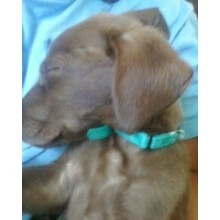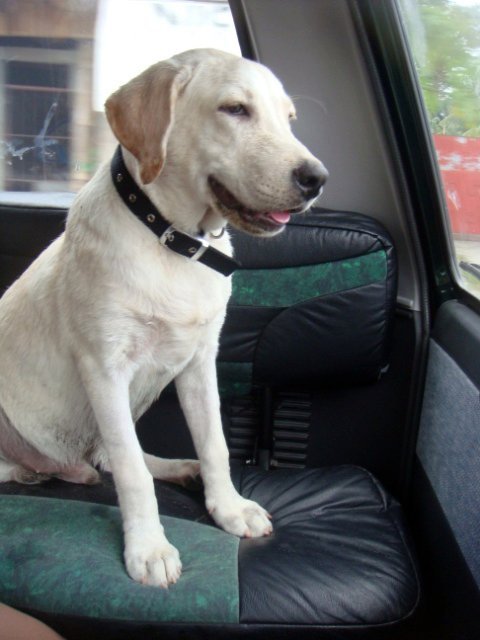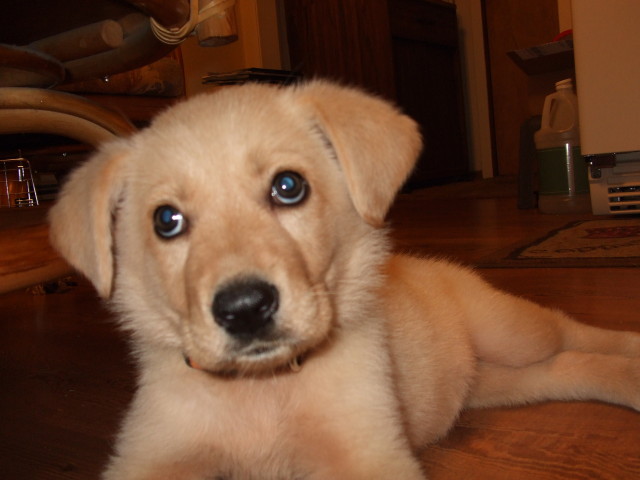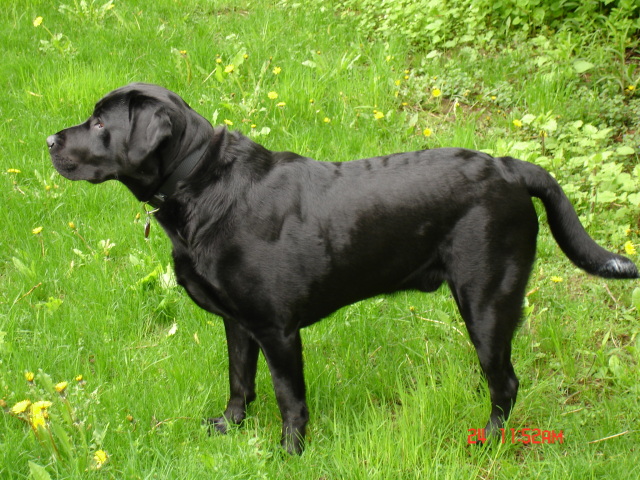QuestionHi i just got a new puppy i believe its called a roly poly cross terrier black lab !!!!! and shes 8 weeks i just wanted to know how many times a day should i feed her and the best way to train her??? thank you.
AnswerFeed 3 meals a day to at least 3 months. If it is more the size of a lab, you can cut back to one meal after 6 months. You need to thin her out, http://www.longliveyourdog.com/twoplus/RateYourDog.aspx
Much of housebreaking is not training the puppy, but making it easier for your puppy, you, and your carpet while its body to catches up to its instincts. At around 8 weeks when the puppy goes to its new home, the time from when it realizes it has to go, and when it can't wait any longer is a matter of seconds. Only time will fix that. You can hardly be expected to be attentive enough to avoid all accidents. There is no sense punishing the puppy for your inattention. It is not fair to punish you either, but you still have to clean it up if you didn't have the puppy outside in time.
Housebreaking starts before you get home with the new puppy. If you don't have a crate, buy one. I prefer the more enclosed, den like plastic ones. Skip the bedding. At first it gets wet, and later it can be chewed into choking hazards. A wire grid in the bottom will help keep the puppy up out of accidents at first. They are available with the crates, but expensive and hard to find. A piece of closely spaced wire closet shelving from a home supply place is cheaper. I am now using a plastic vegetable bin with plenty of holes drilled in the bottom. It helps block off part of the crate for the smaller puppy. If you already have a metal crate, covering it may help. Just make sure you use something the puppy can't pull in and chew. Dogs that start out in crates as little puppies, accept them very well. Never leave an unattended puppy loose in the house. If nobody can watch it, put it in the crate. I suggest letting the dog have its crate all its life. A crate needs to be just big enough for a dog to stretch out in.
Choose a command and spot you want it to use. The less accessible to strays, the less chance of serious disease. If it is a female, choosing a non grassy spot will avoid brown spots later. When you bring it home, take it to the spot and give it the command in a firm, but friendly voice. Keep repeating the command and let the puppy sniff around. Sometimes you need to walk it around to stimulate its body to eliminate. If it does anything, praise it. Really let it know what a good dog it is and how much you love it, and maybe a treat. Note, being out there not only means you can praise it, but it also keeps it from being snatched by a hawk. If it doesn't go, take it inside and give it a drink and any meals scheduled. A young puppy will need to go out immediately afterward. Go to the spot and follow the above routine. Praising it if it goes is extremely important. If it doesn't go, walk it around. They can only walk and hold it so long. If still nothing, take it back inside and put it in its crate and try again soon. Do not let it loose in the house until it does go.
At first it is your responsibility to know and take the puppy out when it needs to go. It needs to go out the first thing in the morning, after eating, drinking, and sleeping. If it quits playing, and starts running around sniffing, it is looking for a place to go. Take it out quickly. You will just have to be what I call puppy broke until it is a little older. How successful you are depends on how attentive you are.
By the time most dogs are about 3 months old, they have figured out that if they go to the door and stand, you will let them out. The praise slowly shifts to going to the door. Some people hang a bell there for the dog to paw. If your dog doesn't figure this out, try praising it and taking it out if it even gets near the door. When you catch it in the act, give it a sharp ''Ah, ah, ah!'' and take it out. Clean up accidents promptly. I mostly keep the little puppies out of the carpeted rooms. Still I need the can of carpet foam sometimes. First blot up all the urine you can with a dry towel. Keep moving it and stepping on it until a fresh area stays dry. A couple big putty knives work well on bowel movements. Just slide one under it while holding it with the other. This gets it up with a minimum of pushing it down into the carpet. This works with even relatively soft ones, vomit, dirt from over turned house plants, or anything else from solids to thick liquids. Finish up with a good shot of carpet foam. Note, do not let the puppy lick up the carpet foam. Once the dog is reliably housebroken, your carpet may need a good steam cleaning.
Many people strongly strongly push cleaning up all evidence of past accidents. I am slower to suggest that. Dogs will return to the same spot if they can find it. When you see one sniffing the spot, that is your clue to run it out.
What does a puppy need?
A crate. It is only natural that a puppy resists its crate at first. What the puppy wants more than anything else is to be others, you, anyone else in the household, and any other pets. In our modern society, even if we are home, other things distract us from the attention an uncrated puppy must have. The only real solution is to crate the dog when you can't give it tha attention it needs. The dog may be happier in its den than loose in the house. It relaxes, it feels safe in its den. It rests, the body slows down reducing the need for water and relieving its self. Dogs that have been crated all along do very well. Many of them will rest in their crates even when the door is open. Skip the bedding. At first it gets wet, and later it can be chewed into choking hazards. A wire rack in the bottom will help keep the puppy up out of accidents at first. They are available with the crates, but a piece of closely spaced wire closet shelving from a home supply place is cheaper. I think the plastic ones give the dog more of a safe, enclosed den feeling. Metal ones can be put in a corner or covered with something the dog can't pull in and chew. Select a crate just big enough for the full grown dog to stretch out in. At first, you may need to block off most of it. At bed time, with a new puppy, I have found lying down in front of the crate like you were going to sleep and speaking softly to it, or singing, until it settles down and goes to sleep works very well. Follow the pattern, a period of active play, outside to eliminate, and then into the crate.
Chew toys. The pet stores are full of toys that many dogs will quickly chew up into pieces they could choke on or cause intestinal blockages. If you are not there to watch, stick to sturdy stuff such as Nylabones and Kongs. Keep a close eye on chew toys and quickly discard anything that is coming apart in pieces. Rawhide is especially bad because it swells after being swallowed. These problems are the worst with, but not limited to, large, aggressive chewers such as Labs.
Food. Find out what the breeder is feeding. If it is dry chow you can buy readily, I would stick with it until the dog is 4 months old, at that time switching to a dry all life stages food. If not, try to have the breeder give you a few days supply to use making a gradual change to a dry puppy chow. In most cases, your best bet is to stick with the breeders food. Many people switch to ''better'' foods and have trouble.
Dishes. Empty plastic food containers are good enough. If you want something nicer, buy the spill proof? ones, stainless steel with an outer skirt making them hard to tip or pick up. I have found them at Big Lots.
A collar and leash. You should stay with a flat fabric or leather collar until your puppy is 5 months old. Then you can go with the metal slip collar with the rings on each end. Otherwise you could damage its windpipe. Put it on like this for the usual dog on the left position. Pull the chain through the one ring forming a"P". Facing the dog, slip it over its head. The free end comes over the neck allowing the other end to release pressure when the leash is slack. A five month old's head will still grow some. If you buy one that easily goes over the head, it still should come off leaving the ears when the dog finishes growing. I start the puppy out with a metal leash and switch to a leather one after the worst of the chewing is over and I need more control. The trend is away from the metal collars to Martingale or head collars. They can be used with younger puppies too.
A name, try http://www.lowchensaustralia.com/names/petnames.htm#1 and http://www.cat-dog-names.com/
A brush. Start the puppy with a soft bristle brush. They don't shed much at first, and the bristle brush will remove dirt and help control odor. When shedding becomes a problem later, switch to a slicker brush with the wire teeth.
The number of a vet. It is very hard to evaluate them. Dogs need more medical care than in the past. Many new problems are wide spread.
A book. Any book is better than none at all. I like the Monks of New Skete and their The Art of Raising a Puppy, ISBN 0-316-57839-8.
Obedience training. A good obedience class or book is about you being top dog, not about rewarding standard commands with a treat. Start obedience training the day you get the dog. Build on the foundation of housebreaking. The younger the puppy, the shorter you must keep sessions, only a few repetitions at a time. A few minutes here and there, and by the time the puppy is 4 months old, people will be impressed with what a nice dog it is.
An All Experts bookmark so you can come back for help as needed.
I didn't forget treats, shampoo, and bedding. I seldom use them.

 Lab eating my house! (and everything else)
Question
Pepper
I have a sweet sweet black female lab t
Lab eating my house! (and everything else)
Question
Pepper
I have a sweet sweet black female lab t
 11 week old chocolate lab
Question
11 week old lab
We recently got a chocolate la
11 week old chocolate lab
Question
11 week old lab
We recently got a chocolate la
 Dog breed
Question
Puto.
We have crossed bred dogs in the house a
Dog breed
Question
Puto.
We have crossed bred dogs in the house a
 Young pup drinks too much
Question
Hi, Im Roxy & I have
I recently adopted a
Young pup drinks too much
Question
Hi, Im Roxy & I have
I recently adopted a
 shedding, size, uncontrolled around other dogs
Question
Sawyer
My 13 month old black lab is shedding u
shedding, size, uncontrolled around other dogs
Question
Sawyer
My 13 month old black lab is shedding u